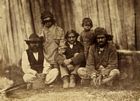In 1838 an Aboriginal Protectorate was established in Port Phillip with the dual aims of upholding the rights and privileges of Aboriginal people as British subjects and ‘civilising’ the Indigenous population by encouraging them to settle in prescribed areas, and to be educated, particularly in Christianity.
The Protectorate comprised a Chief Protector (George Augustus Robinson, who came to Port Phillip from Van Diemen’s Land where he had been a key figure in mediations between Aboriginal people and colonists), and four Assistant Protectors. One of these, Edward Stone Parker, had responsibility for Aboriginal people in the northwest or Loddon district, which was later to become the site of the first goldrushes. Parker commenced his work in September 1839.
The site of the Loddon Protectorate shifted a few times, before Parker settled at Franklinford in June 1841. A large number of Djadjawurrung went with Parker to the station at Franklinford, largely for pragmatic reasons in the face of rapid pastoral expansion in the district. Up to 200 Aboriginal people lived on the Protectorate during the 1840s. In return for their work on the station, the Protectorate provided rations, medical assistance and education and religious instruction.
In his capacity as Assistant Protector, Parker attempted to prosecute several men for killing Aboriginal people in 1840 and 1841. Both cases failed due to the inadmissibility of Aboriginal people’s evidence in court – regarded as heathens, they could not swear on the Bible.
In December 1849, a select committee recommended the abolition of the Protectorate and Robinson and his team of Assistant Protectors were relieved of their duties. Although the Loddon Protectorate was effectively abolished, Parker received permission from the government to stay on at Mt Franklin. Parker continued to operate a pastoral run, as well as a school. Many members of the Djadjawurrung remained living on the site of the Protectorate from 1849.
Parker maintained a great interest in educating, and thereby ‘civilising’, the younger members of the Indigenous population. In a letter to G A Robinson, Parker wrote of his belief that young Aboriginal people’s minds ‘need to be emancipated from the darkness and thraldom of their native superstitions’. Parker also wrote several letters to the authorities recommending that teaching be conducted in the Djadjawurrung’s own language.
After the massive changes brought by the goldrushes from 1851, only a small number of Djadjawurrung chose to remain at Franklinford on the land now leased privately to Parker. Two men, Yerrebulluk or Dicky (1827-62) and Beernbarmin or Tommy Farmer (c.1827-80) were granted a lease on 21 acres at Franklinford and farmed it for themselves and their families. Bain Attwood describes this community of farmers as ‘a small core of men and women who were drawn to their white protector and who became Christian as well as keen and hard-working farmers’. They grew crops on the land and sold them to the people flocking to the diggings.
But in the early 1860s, the members of this small community were moved from their homes at Franklinford onto the Coranderrk station near Healesville (some Aboriginal people living in Ballarat were moved to Framlingham in Western Victoria), following the establishment of the Board for the Protection of the Aborigines, yet another attempt by the government to ‘protect’ and ‘civilise’ the Indigenous population.


